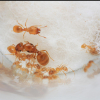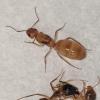May 16, 2019
This colony has yet to even reach near 100 workers. It's weird, they always have brood but it takes forever for me to notice considerable growth in them. I'm thinking the workers have a short lifespan. Tropical species like this don't seem to lay in batches, they just lay a few eggs here and there. I probably should be feeding them more carbs and less protein.





Edited by Aaron567, May 16 2021 - 1:28 PM.


























